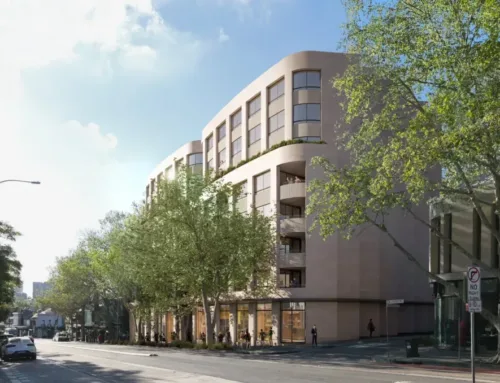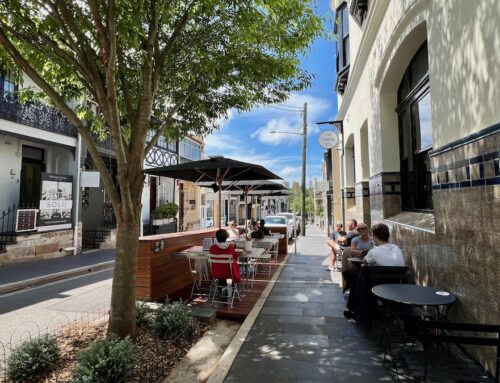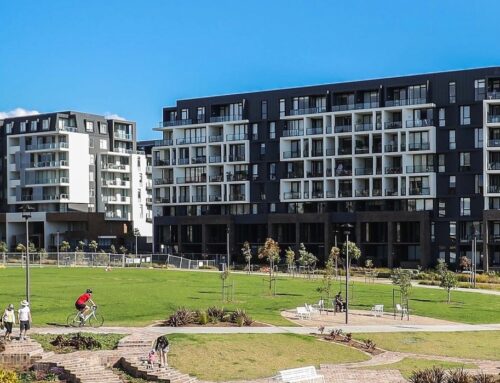The Committee has actively participated in two recent community-led forums on this issue.
“Community Need Not Developer Greed”
Sponsored by Nicola Grieve, Greens Councillor for Woollahra
23 July at Waverley Community Centre
The first speaker was James Ryan, Solicitor, recently for The Total Environment Centre. He warned that, as currently drafted, the Reforms will drastically decrease green space and solar access on housing lots and that the proposed height and floor space ratio standards are far in excess of existing terrace housing density. Trees will be lost and 6-8 storey heights will dominate the existing scale of our streets.
He pointed out that the new standards will prevail over local heritage controls, and that any dispute the Council has with applicants would likely lead to appeals in the Land and Environment Court which will likely uphold the SEPP. He could only conclude that the intent of the new standards applying in Heritage Conservation Areas (HCAs) is to facilitate large-scale redevelopment in these areas. Ryan believes the housing crisis is not simply a matter of lack of supply – there are other factors such as vacancies, replacing small units with luxury apartments, land-banking by developers, taxation, and immigration.
The second speaker was Linda Gosling, Vice President of The Paddington Society, who addressed the impacts on Paddington’s built heritage. She feared that the YIMBY advocacy group, along with developers, has persuaded the State Government that heritage is a luxury that we cannot afford, and that HCAs should be reduced to 5-10% of their current area.
But she pointed out that in the main the heritage value of Paddington is the entire Victorian suburb of consistent 2-storey scale and that the whole is important not just a token street. The danger is that the new standards are proposed to be in SEPPs which trump Council controls, and to be ‘non-refusable’ standards. They will be tied to land use zoning rather than the Council’s place-based strategic planning which has prevailed till now.
Amendments the Society would like to see are:
- Mid-rise density (6-8 storeys) should not apply in HCAs, and heritage should be valued
- South Paddington residential areas should be rezoned to R2 (where lower density standards apply), consistent with the R2 zoning on the north side.
- Secondary dwellings should be encouraged on larger lots, to increase the housing supply.
- Oxford St or Five Ways should not be classed as Town Centres nor should the light rail stops be classified as Transport Hubs, both triggering the higher densities.
- The State Government should consult with the community on how these reforms apply.
The last speaker was Sue Higginson, NSW Greens Senator and environmental lawyer. Sue characterised the reforms as ‘anti-intellectual’ and a blunt instrument, designed to increase housing supply at the expense of heritage and the environment, and flying in the face of many years of Council strategic planning which looked at the best way of increasing density over the LGA.
She also pointed out the token affordable housing component in these reforms, in what will be a huge redevelopment over much of Sydney. She believes that the value uplift that will ensue should be taxed and used for affordable housing, not just pocketed as profit and that the State Government must step in and build publicly-owned affordable housing. Sue directed us to the NSW Greens policies on Housing (and Heritage).
“Getting Housing Right: Why it Matters”
Hosted by the Save Greater Sydney Coalition
7 August at NSW Parliament House
Speakers were: Saul Deane from The Total Environment Centre, Sharon Veale, Heritage Consultant, Peter Sheridan from Potts Point Preservation Group, Michael Pascoe, financial journalist, and Elizabeth Farrelly, architectural journalist. Joseph O’Donoghue, author, MC’d.
Points that emerged from the presentations included:
- A proper analysis of the housing problem is needed, not the simplification that the NSW government is offering or the scapegoating of planning and Councils – binary narratives such as YIMBY vs NIMBY will only lead to poor quality outcomes.
- Strategic planning will lead to better outcomes than blanket rezoning.
- SEPPs are made by the Planning Minister and don’t need Parliamentary approval or community consultation.
- There are more votes in the rental and purchasing two-thirds of the population, rather than in the remaining house-owning third – it is largely the latter sector that is concerned with ‘place’, ‘character’ or heritage, though all sectors will be affected by their loss.
- We need a greener and denser city, based on the ‘Blue-Green Grid’ vision, where riparian corridors provide natural sanctuaries, and where deep soil is mandated for residential development.
- Developer-driven planning will not deliver cheaper housing.
- The government needs to bring in a windfall gains tax (as in other countries)
- Heritage does matter in a housing crisis as it is a connection to our history and our community – there are good examples of respectful infill and adaptive reuse in heritage areas.
- Studio and 1 bed apartments, and 20th century heritage, need to be retained in Potts Point, already the highest density residential area in Sydney.
- Cities are custodians of heritage, but heritage has been weaponised in this housing debate.
- Public-owned housing, as well as affordable housing, is needed since the existing proportion of public and community housing has been falling since the 1980s.
- Landlordism, not supply, is at the heart of the housing crisis since landlords increase rents unchecked and enjoy wealth-entrenching tax breaks.
- Housing as speculative investment needs to be curbed, and tax breaks and land banking ended to make housing more affordable to both buy and rent.
For more details of the presentations, see foke.org.au
We urge you to write to the NSW Planning Minister Paul Scully with your concerns BEFORE the reforms are finalised into a State Environmental Planning Policy (or SEPP)– due to be issued in September.





